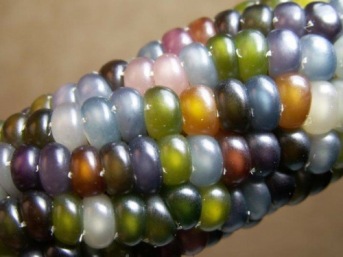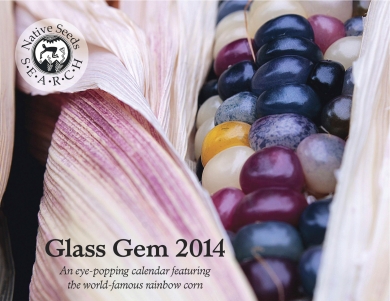December 17, 2013
In the grocery store the other day, my two-year old son saw a cello-wrapped package of corn on the cob. “Can we get corn?” he asked.
“We eat corn in the summer,” I responded and rolled our cart on. I’m the kind of mother who imposes arbitrary and joy-killing rules, even about produce.
Later, he saw the photos of Glass Gem Corn I was admiring on my laptop.

The photo that inspired thousands to plant colorful corn. Glass Gem Corn image from the Native Seed/SEARCH website.
“Can we eat that?” he asked hopefully. “Are you ordering it?”
“No. It’s just for looking.”
“Okay. Looking is fun.”
In the case of most foods, looking doesn’t satisfy a two year old (or his 35 year old mother). In the case of glass gem corn, looking is wonderful.
Corn has received a lot of bad press in recent years. I’ve read news items about corn taking over the American diet (in the form of corn syrup), GM varieties wiping out heirloom and indigenous crops, and movie theaters serving eight day old popcorn shipped from central warehouses instead of freshly popped kernels.
Happily, today I’ve got an upbeat story about corn, a tale about the survival of an heirloom crop, a farmer’s legacy turned legend, and a humble seed gaining fame and fortune. Well, not fortune exactly, but the fame part is spot on.
In Oklahoma, Carl Barnes, a part-Cherokee farmer began breeding his most colorful corn. Realizing he’d created something special, and approaching old age, he gave his seed collection to Greg Schoen, his corn seed protégé, who, in turn, shared the seeds with an Arizona seed company, Seeds Trust. The owner of Seeds Trust became the Executive Director of the organization Native Seeds/SEARCH and heirloom Glass Gem Corn seeds are now available to the world.
In 2012, the story of Glass Gem Corn spread far and wide via the wonders of the internet and a compelling photo. Now the corn is highly sought after and grown by corn lovers near and far. People are even adorning their cars with bumper stickers proclaiming their affection for Glass Gem Corn. Best of all, every bumper sticker and seed packet purchased supports Native Seeds/SEARCH, an impressive organization dedicated to protecting, studying, and promoting wild and agricultural seeds of the American Southwest and Northwest Mexico.
Glass Gem corn isn’t especially delicious or hardy. It’s simply beautiful. Each seed yields unique color combinations.
So, there you go: A story about corn that has nothing to do with obesity, the end of plant diversity, or movie theater disappointments. Some heirloom crops are truly thriving, the internet is helping, and many people care about keeping the plant world vibrant and diverse.
The stunning, shining colors of glass gem, like most of the best pleasures, are ephemeral. Glass Gem Corn can be dried for ornamental purposes, but I suspect the highlight of a glass gem harvest is shucking each ear and seeing the wondrous and surprising kernels shining and plump.
Glass Gem is a flint corn, good for grinding into flour. You can use it to make popcorn as well, but, alas, neither the flour nor popcorn will be rainbow hued.
If you’re a produce nerd like me and my two year old, and you’d like to see more images of Glass Gem Corn, there is a Facebook page dedicated to the variety, where people post photos. You can order your own seed packet from Native Seeds/SEARCH. The organization has even pulled together a beautiful Glass Gem calendar, full of stunning photos, the perfect holiday gift for the plant enthusiast in your family. Pair it with my plant preservation-themed novel, DROWNING CACTUS, and you’ve got Christmas taken care of!

The beautiful Glass Gem Calendar available from Native Seeds/SEARCH.
So, here we are with an aseasonal post about corn. To avoid any accusations of hypocrisy, I’ll be off to the market shortly to buy my son that fresh corn, and tonight, I’ll be making pan roasted sweet corn, a treat usually reserved for late summer months. Here’s the recipe, if you feel like a break from mince pies or egg nog.
Spicy, Smoky Sweet Corn
– adapted from Mark Bittman’s 101 Simple Salads for the Season, #39.
Ingredients:
2 Tbsp vegetable oil
4 ears of corn, kernels sliced off the cob
1 Green pepper, chopped into 1 inch chunks
2 habaneros, diced
Salt and pepper to taste
2 tsp roughly chopped cilantro
Heat oil on high in a wide pan. Toss in corn kernels, green pepper and habanero along with a generous amount of salt and pepper to taste. Stir frequently until the corn kernels are fully cooked, and some blackened. Serve warm, topped with cilantro.
Posted by carrierussellbooks in Environmental Tags: Carl Barnes, Corn, Diversity, Glass Gem, Glass Gem Corn, Greg Schoen, heirloom, Native Seeds, Native Seeds/SEARCH, Plant, Seed, Sustainable





